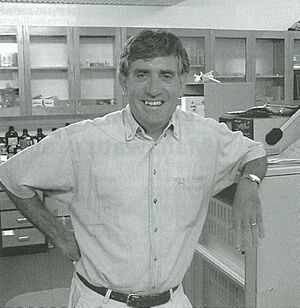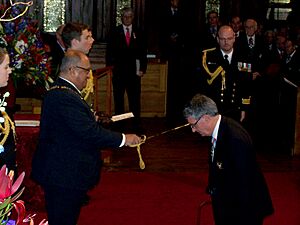Paul Callaghan facts for kids
Quick facts for kids
Sir Paul Callaghan
GNZM FRS FRSNZ
|
|
|---|---|

Callaghan in 2001
|
|
| Born |
Paul Terence Callaghan
19 August 1947 Whanganui, New Zealand
|
| Died | 24 March 2012 (aged 64) Wellington, New Zealand
|
| Education |
|
| Known for | NMR and MRI research |
| Awards | New Zealand Order of Merit Rutherford Medal Günther Laukien Prize James Cook Research Fellowship (2008) 2011 New Zealander of the Year |
| Scientific career | |
| Fields | Physics, molecular physics |
| Institutions | Massey University |
| Thesis | Some hyperfine interaction studies using nuclear orientation (1974) |
| Doctoral advisor | Nicholas James Stone |
Sir Paul Terence Callaghan (born August 19, 1947 – died March 24, 2012) was a famous New Zealand physicist. He was a key leader in science, especially in the study of tiny materials. He helped start the MacDiarmid Institute for Advanced Materials and Nanotechnology in Wellington. He also led the International Society of Magnetic Resonance.
Contents
Paul Callaghan's Life Story
Paul Callaghan was born in Whanganui, New Zealand, on August 19, 1947. His parents were Mavis and Ernest Callaghan. He had an older brother, Jim, and two sisters, Jeanine and Mary.
He went to Wanganui Technical College (now Wanganui City College). Paul then studied physics at Victoria University of Wellington. Later, he earned a special degree called a DPhil from the University of Oxford in England. There, he studied how things behave at very cold temperatures.
His Work in New Zealand
In 1974, Paul came back to New Zealand. He started teaching at Massey University. This is where he began his important research. He looked at how magnetic resonance could be used to study "soft matter." Soft matter includes things like liquids, gels, and plastics.
By 1984, he became a Professor of Physics. In 2001, he was named the Alan MacDiarmid Professor of Physical Sciences. The next year, he helped create the MacDiarmid Institute. This institute brings together different universities to study advanced materials and nanotechnology (the science of very, very small things).
Sharing Science with Everyone
Paul Callaghan was also the President of the Academy Council of the Royal Society of New Zealand. He wrote over 240 scientific articles. He also wrote books like Principles of Nuclear Magnetic Resonance Microscopy (1994) and Translational Dynamics and Magnetic Resonance (2011).
He helped start Magritek, a company in Wellington. This company makes instruments for NMR and MRI. Paul loved to talk about science to the public. He even had radio discussions with Kim Hill, which became a book called As Far as We Know.
He also wrote Wool to Weta (2009). This book was about how science and technology could help New Zealand's economy. He also presented a documentary about this idea.
Awards and Recognition
In 2001, Paul Callaghan became a Fellow of the Royal Society of London. This is a very high honor for scientists. He won the Ampere Prize in 2004 and the Rutherford Medal in 2005. These awards recognized his amazing work in physics.
He received the Principal Companion of the New Zealand Order of Merit in 2006. In 2007, he got a World Class New Zealander Award and the Sir Peter Blake Medal. He also received a special two-year research fellowship in 2008. In 2009, he was knighted, becoming Sir Paul Callaghan.
He continued to receive awards, including the Günther Laukien Prize in 2010. He also shared the New Zealand Prime Minister's Science Prize. In 2011, he was named Kiwibank's New Zealander of the Year.
Paul Callaghan passed away on March 24, 2012, at the age of 64. He was survived by his first wife, Sue Roberts, their two children, Catherine and Chris, and his second wife, Miang Lim. After he passed away, he was again honored as the Supreme winner of the World Class New Zealand award in 2012.
A New Zealand government organization, Callaghan Innovation, was named after him in 2013. This shows how important his work was for the country.
What Paul Callaghan Studied
Paul Callaghan wrote more than 230 articles for science journals. His research team focused on new ways to use NMR. They used it to study how molecules move and are organized in liquids, soft materials, and porous materials. Some of his main contributions include:
- Rheo-NMR: This is a way to study how fluids flow using nuclear magnetic resonance.
- Diffusion in porous media: He studied how molecules spread out in materials with tiny holes, like sea ice.
- Earth's magnetic field NMR: He developed NMR methods that use the Earth's own magnetic field.
Important Jobs He Held
- 1974: Lecturer at Massey University, Palmerston North
- 1984: Professor of Physics at Massey University, Palmerston North
- 2001: Alan MacDiarmid Professor of Physical Sciences at Victoria University, Wellington
Awards and Honours
- 2001: Elected a Fellow of the Royal Society
- 2004: Ampere Prize
- 2005: Rutherford Medal
- 2006: Principal Companion of the New Zealand Order of Merit
- 2007: Sir Peter Blake Medal
- 2008: Dan Walls Medal (first person to receive it)
- 2008: James Cook Research Fellowship from the Royal Society of New Zealand
- 2009: Knighted
- 2010: Günther Laukien Prize for Magnetic Resonance
- 2010: New Zealand Prime Minister's Science Prize
- 2011: New Zealander of the Year
The Callaghan Medal
The Royal Society of New Zealand created the Callaghan Medal in 2011. This medal is given to people who do a great job of sharing science with the public. It celebrates those who help everyone understand how important science is. Past winners include:
- 2011: Peter Gluckman
- 2012: Shaun Hendy
- 2013: Siouxsie Wiles
- 2014: Peter Dearden
- 2015: Michelle Dickinson
- 2016: Hamish Spencer
- 2017: Peter Shepherd
- 2018: Helen Taylor
- 2019: Ocean Mercier
- 2020: Rangi Mātamua
- 2022: Michael Baker
- 2023: Mike Joy
Books by Paul Callaghan
- Callaghan, P. (1994). Principles of Nuclear Magnetic Resonance Microscopy.
- Callaghan, P. and Hill, K. (2007). As Far as We Know: Conversations about Science, Life and the Universe.
- Callaghan, P. (2009). Wool to Weta: Transforming New Zealand's Culture and Economy.
- Callaghan, P. (2011). Translational Dynamics and Magnetic Resonance: Principles of Pulsed Gradient Spin Echo NMR.
- Callaghan, P. and Hendy, S. (2013). Get off the Grass: Kickstarting New Zealand’s Innovation Economy.


